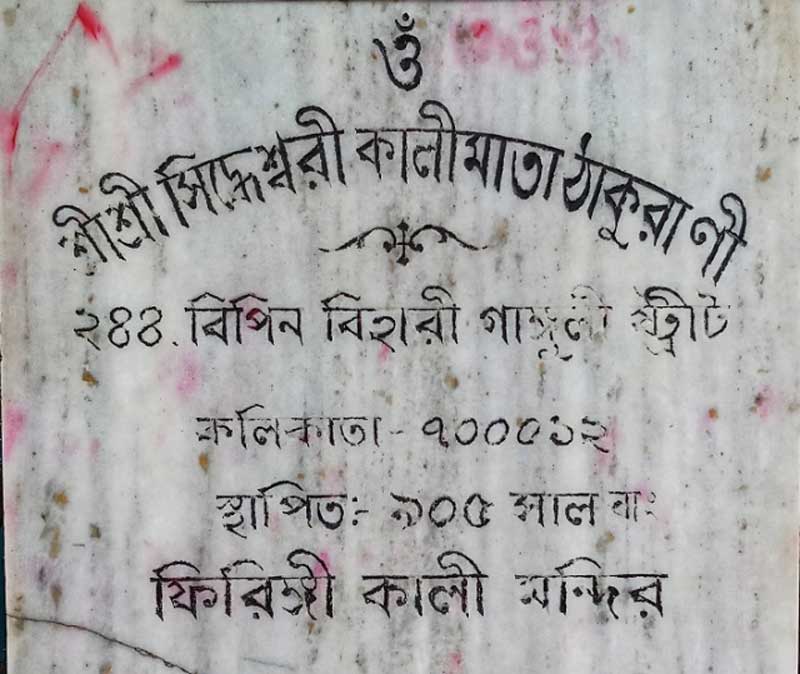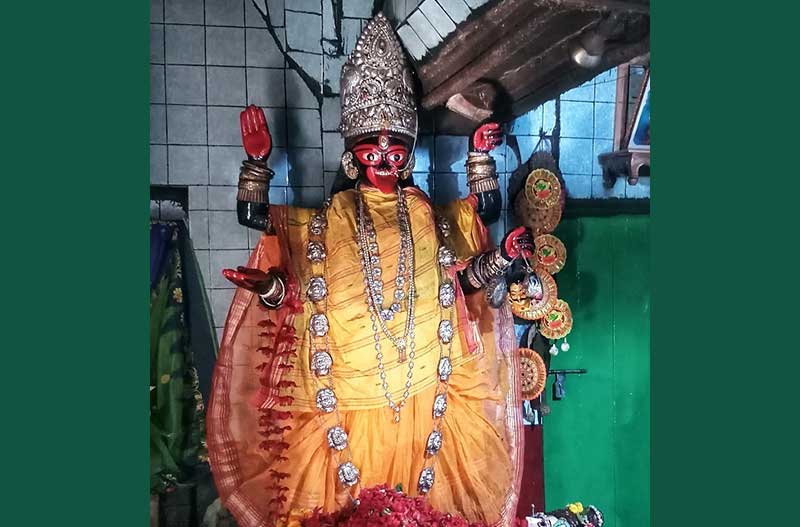
Goddess Kali, the chief of the Mahavidyas or the ten aspects of Parvati in Hinduism, is widely worshipped in Eastern India, especially most of the Bengalis are historically ardent worshippers of the goddess Kali, the divine mother. Apart from the famous Kalighat and Dakshineswar Kali Temples, Calcutta has many other popular and widely visited Kali temples where the idol of the goddess is regularly worshipped. The Firingi Kalibari, located at 244 Bow Bazar Street (renamed Bipin Bihari Ganguly Street) and dedicated to Siddheswari Kali, is one of such temples.
Ridiculously, although the small and unimpressive temple is supposed to be 500 years old, it looks almost new due to the mindless, careless, and disastrous renovation.

Like many other old temples in the country, no recorded history of the Firingi Kalibari is available. Contrary to the belief that it was founded by a Firingi, a non-Hindu foreigner, essentially of European origin, a plaque on the outer wall of the temple suggests that it was erected in 905 Bangabda, or around 1498 AD, which makes it far older than the European settlement in the city.
According to Calcutta Old and New, a historical and descriptive handbook of the city written by Sir Harry Evan Auguste Cotton, the temple was initially established by Srimanta Dom, considered to be a man of very low caste, mainly associated with the cremation of the bodies belonging to Hinduism. As he belonged to a low caste, he was not in a social position to have a Brahmin priest in his temple, so he himself used to perform the duties of the priest. At the same time, he also worshipped an idol of Goddess Sitala, a folk deity, believed to cure diseases like poxes, sores, and abscesses and used to treat and heal the patients of smallpox.

According to another legendary story, the temple was initially a Shiva temple where the idol of Kali was installed much later on Panchamundi Asan, most probably by Antony Firingi. Indeed, under the main dome of the temple, there is a Shivlinga, and the idol of Kali is quite far from it, almost at one corner of the temple. Nevertheless, the association of the temple with Anthony Firingi is well known. Anthony, a Portuguese, was born as Hensman Anthony and arrived in Bengal sometime in the early 19th century.
Gradually, he became deeply influenced by the Bengali culture and language, embraced Hinduism, and married a Hindu Brahmin widow named Saudamini. Soon he established himself as a kabial, proficient in kabigan, a verbal duel, wherein folk poets sing and perform. He also became a devotee of goddess Kali and composed several devotional songs.

The Firingi Kalibari is located in a busy and crowded area of the city. The outside walls of the modest structure of the temple are now clad in marble, and the name of the temple is carved in metal. There are also two marble plaques indicating the name, assumed date of foundation, and the address of the temple.

There are three entrances to the main sanctum sanctorum of the temple, housing the main deity of goddess Kali on Lord Shiva, along with the smaller idols of goddess Sitala, goddess Manasa, and a Shivalinga, an abstract or aniconic representation of Lord Shiva. Although the temple is well maintained and clean, most of the people have to pray or pay respect from outside, due to insufficient space inside the temple.